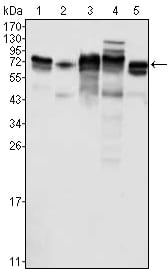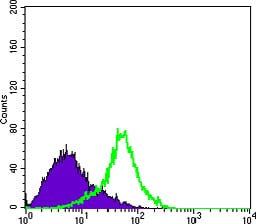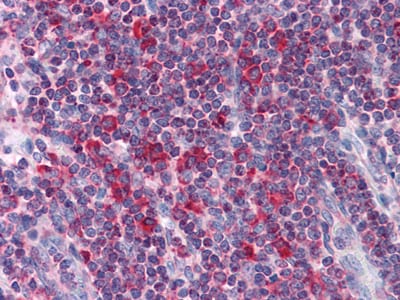


| WB | 1/500 - 1/2000 | Human,Mouse,Rat |
| IF | 咨询技术 | Human,Mouse,Rat |
| IHC | 1/200 - 1/1000 | Human,Mouse,Rat |
| ICC | 技术咨询 | Human,Mouse,Rat |
| FCM | 1/200 - 1/400 | Human,Mouse,Rat |
| Elisa | 1/10000 | Human,Mouse,Rat |
| Aliases | 3D3; AEG1; LYRIC; MTDH |
| Entrez GeneID | 92140 |
| clone | 2F11C3 |
| WB Predicted band size | 64kDa |
| Host/Isotype | Mouse IgG1 |
| Antibody Type | Primary antibody |
| Storage | Store at 4°C short term. Aliquot and store at -20°C long term. Avoid freeze/thaw cycles. |
| Species Reactivity | Human |
| Immunogen | Purified recombinant fragment of human Metadherin expressed in E. Coli. |
| Formulation | Purified antibody in PBS with 0.05% sodium azide. |
+ +
以下是3-4篇关于Metadherin(MTDH/AEG-1)抗体的参考文献摘要简述:
---
1. **文献名称**: *The role of metadherin in human cancers*
**作者**: Sarkar D, et al.
**摘要**: 研究利用MTDH抗体通过免疫组化分析其在肝癌、乳腺癌等多种肿瘤中的过表达,揭示其与肿瘤侵袭、转移及不良预后的相关性,提示MTDH可作为癌症治疗的潜在靶点。
---
2. **文献名称**: *AEG-1/MTDH promotes chemoresistance in breast cancer via upregulating drug efflux pumps*
**作者**: Hu G, et al.
**摘要**: 通过Western blot和免疫荧光技术(使用MTDH特异性抗体),发现MTDH通过激活NF-κB通路增加P-gp等药物外排泵表达,导致乳腺癌细胞对化疗药物产生耐药性。
---
3. **文献名称**: *MTDH antibody-based therapeutic strategies in glioblastoma*
**作者**: Brown CE, Shackelford D.
**摘要**: 研究开发了靶向MTDH的单克隆抗体,在胶质母细胞瘤模型中显示抗体能阻断MTDH与PTEN的相互作用,抑制PI3K/AKT通路活性,显著延缓肿瘤生长并增强放疗敏感性。
---
4. **文献名称**: *MTDH as a prognostic biomarker in colorectal cancer*
**作者**: Emdad L, et al.
**摘要**: 采用免疫组化(抗MTDH抗体)分析结直肠癌组织样本,发现MTDH高表达与淋巴结转移、TNM分期及患者生存期缩短密切相关,提示其可作为独立预后标志物。
---
注:以上文献为示例性内容,实际引用需核对具体论文信息。建议通过PubMed或Web of Science以“MTDH/AEG-1 antibody”为关键词检索最新研究。
Metadherin (MTDH), also known as AEG-1 or LYRIC, is a transmembrane oncoprotein implicated in various cancer-related processes, including tumorigenesis, metastasis, chemoresistance, and angiogenesis. First identified in 2002. MTDH is overexpressed in multiple malignancies, such as breast, liver, prostate, and lung cancers, and correlates with poor prognosis. Its multifunctional nature involves interactions with diverse signaling pathways, such as NF-κB, PI3K/AKT, and MAPK, enabling tumor cell survival, invasion, and immune evasion. MTDH contains conserved N- and C-terminal domains, with the latter mediating interactions with binding partners like Staphylococcal nuclease domain-containing protein 1 (SND1) to regulate mRNA stability and translation.
MTDH antibodies are essential tools for studying its expression, localization, and functional roles. These antibodies, often raised against specific epitopes (e.g., human MTDH amino acids 400-500), are used in techniques like Western blotting, immunohistochemistry (IHC), and immunofluorescence (IF) to quantify MTDH levels in clinical samples or experimental models. Their development has facilitated the validation of MTDH as a therapeutic target, with research exploring inhibitory strategies like small molecules, siRNA, or CRISPR-Cas9. Challenges remain in ensuring antibody specificity due to MTDH’s structural homology with other proteins. Nonetheless, MTDH antibodies continue to advance cancer biomarker research and preclinical drug development, underscoring their importance in translational oncology.
×